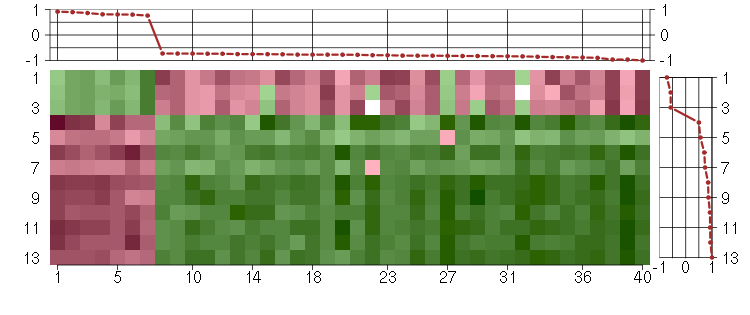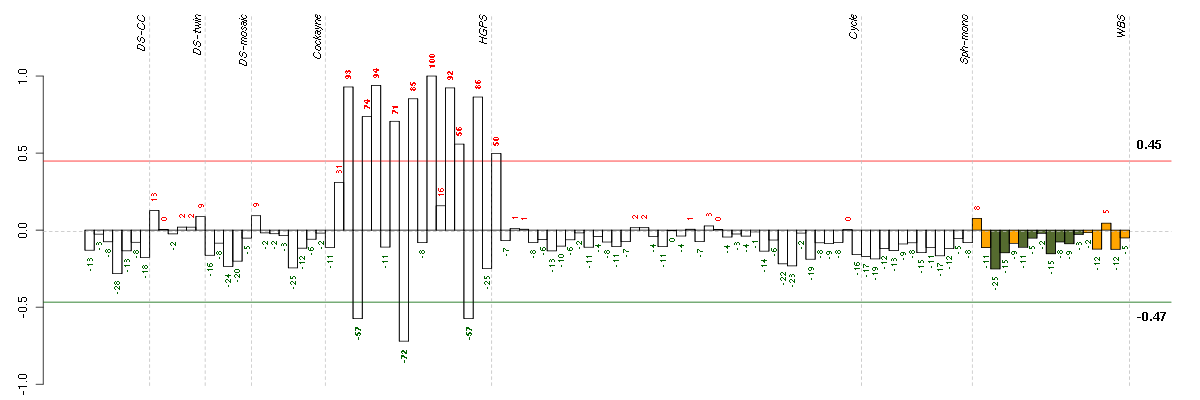



Under-expression is coded with green,
over-expression with red color.

metabolic process
The chemical reactions and pathways, including anabolism and catabolism, by which living organisms transform chemical substances. Metabolic processes typically transform small molecules, but also include macromolecular processes such as DNA repair and replication, and protein synthesis and degradation.
multicellular organismal development
The biological process whose specific outcome is the progression of a multicellular organism over time from an initial condition (e.g. a zygote or a young adult) to a later condition (e.g. a multicellular animal or an aged adult).
biological_process
Any process specifically pertinent to the functioning of integrated living units: cells, tissues, organs, and organisms. A process is a collection of molecular events with a defined beginning and end.
multicellular organismal process
Any biological process, occurring at the level of a multicellular organism, pertinent to its function.
developmental process
A biological process whose specific outcome is the progression of an integrated living unit: an anatomical structure (which may be a subcellular structure, cell, tissue, or organ), or organism over time from an initial condition to a later condition.
collagen metabolic process
The chemical reactions and pathways involving collagen, any of a group of fibrous proteins of very high tensile strength that form the main component of connective tissue in animals. Collagen is highly enriched in glycine (some regions are 33% glycine) and proline, occurring predominantly as 3-hydroxyproline (about 20%).
macromolecule metabolic process
The chemical reactions and pathways involving macromolecules, any molecule of high relative molecular mass, the structure of which essentially comprises the multiple repetition of units derived, actually or conceptually, from molecules of low relative molecular mass.
multicellular organismal metabolic process
The chemical reactions and pathways in multicellular organisms that occur at the tissue, organ, or organismal level. These processes, unlike cellular metabolism, can include transport of substances between cells when that transport is required.
multicellular organismal macromolecule metabolic process
The chemical reactions and pathways involving macromolecules, large molecules including proteins, nucleic acids and carbohydrates, in multicellular organisms occurring at the tissue, organ, or organismal level.
all
This term is the most general term possible
multicellular organismal metabolic process
The chemical reactions and pathways in multicellular organisms that occur at the tissue, organ, or organismal level. These processes, unlike cellular metabolism, can include transport of substances between cells when that transport is required.
multicellular organismal development
The biological process whose specific outcome is the progression of a multicellular organism over time from an initial condition (e.g. a zygote or a young adult) to a later condition (e.g. a multicellular animal or an aged adult).
multicellular organismal macromolecule metabolic process
The chemical reactions and pathways involving macromolecules, large molecules including proteins, nucleic acids and carbohydrates, in multicellular organisms occurring at the tissue, organ, or organismal level.

intracellular
The living contents of a cell; the matter contained within (but not including) the plasma membrane, usually taken to exclude large vacuoles and masses of secretory or ingested material. In eukaryotes it includes the nucleus and cytoplasm.
contractile fiber
Fibers, composed of actin, myosin, and associated proteins, found in cells of smooth or striated muscle.
cellular_component
The part of a cell or its extracellular environment in which a gene product is located. A gene product may be located in one or more parts of a cell and its location may be as specific as a particular macromolecular complex, that is, a stable, persistent association of macromolecules that function together.
cell
The basic structural and functional unit of all organisms. Includes the plasma membrane and any external encapsulating structures such as the cell wall and cell envelope.
cytoplasm
All of the contents of a cell excluding the plasma membrane and nucleus, but including other subcellular structures.
myofibril
The contractile element of skeletal and cardiac muscle; a long, highly organized bundle of actin, myosin, and other proteins that contracts by a sliding filament mechanism.
sarcomere
The repeating unit of a myofibril in a muscle cell, composed of an array of overlapping thick and thin filaments between two adjacent Z discs.
intracellular part
Any constituent part of the living contents of a cell; the matter contained within (but not including) the plasma membrane, usually taken to exclude large vacuoles and masses of secretory or ingested material. In eukaryotes it includes the nucleus and cytoplasm.
cytoplasmic part
Any constituent part of the cytoplasm, all of the contents of a cell excluding the plasma membrane and nucleus, but including other subcellular structures.
contractile fiber part
Any constituent part of a contractile fiber, a fiber composed of actin, myosin, and associated proteins, found in cells of smooth or striated muscle.
cell part
Any constituent part of a cell, the basic structural and functional unit of all organisms.
all
This term is the most general term possible
cell part
Any constituent part of a cell, the basic structural and functional unit of all organisms.
intracellular part
Any constituent part of the living contents of a cell; the matter contained within (but not including) the plasma membrane, usually taken to exclude large vacuoles and masses of secretory or ingested material. In eukaryotes it includes the nucleus and cytoplasm.
cytoplasmic part
Any constituent part of the cytoplasm, all of the contents of a cell excluding the plasma membrane and nucleus, but including other subcellular structures.
contractile fiber part
Any constituent part of a contractile fiber, a fiber composed of actin, myosin, and associated proteins, found in cells of smooth or striated muscle.
sarcomere
The repeating unit of a myofibril in a muscle cell, composed of an array of overlapping thick and thin filaments between two adjacent Z discs.

ANK3ankyrin 3, node of Ranvier (ankyrin G) (206385_s_at), score: -0.79 ANKRD1ankyrin repeat domain 1 (cardiac muscle) (206029_at), score: -0.82 AUTS2autism susceptibility candidate 2 (212599_at), score: 0.81 BST1bone marrow stromal cell antigen 1 (205715_at), score: -0.75 C1orf54chromosome 1 open reading frame 54 (219506_at), score: -0.77 CAMK2N1calcium/calmodulin-dependent protein kinase II inhibitor 1 (218309_at), score: 0.92 CCDC81coiled-coil domain containing 81 (220389_at), score: -0.73 EPHA5EPH receptor A5 (215664_s_at), score: -0.84 F2Rcoagulation factor II (thrombin) receptor (203989_x_at), score: -0.77 GPR116G protein-coupled receptor 116 (212950_at), score: -1 HS3ST3A1heparan sulfate (glucosamine) 3-O-sulfotransferase 3A1 (219985_at), score: 0.86 ITGA7integrin, alpha 7 (216331_at), score: -0.74 JAG1jagged 1 (Alagille syndrome) (216268_s_at), score: -0.81 KALRNkalirin, RhoGEF kinase (206078_at), score: -0.78 KCNE4potassium voltage-gated channel, Isk-related family, member 4 (222379_at), score: -0.73 LGALS3BPlectin, galactoside-binding, soluble, 3 binding protein (200923_at), score: -0.73 LMO2LIM domain only 2 (rhombotin-like 1) (204249_s_at), score: -0.87 LPHN2latrophilin 2 (206953_s_at), score: -0.83 LRRC15leucine rich repeat containing 15 (213909_at), score: 0.81 LRRC17leucine rich repeat containing 17 (205381_at), score: -0.73 MBPmyelin basic protein (210136_at), score: -0.88 MEOX2mesenchyme homeobox 2 (206201_s_at), score: -0.96 MGPmatrix Gla protein (202291_s_at), score: -0.85 MMP2matrix metallopeptidase 2 (gelatinase A, 72kDa gelatinase, 72kDa type IV collagenase) (201069_at), score: 0.76 NDUFA4L2NADH dehydrogenase (ubiquinone) 1 alpha subcomplex, 4-like 2 (218484_at), score: -0.79 NRXN3neurexin 3 (205795_at), score: -0.81 PDE10Aphosphodiesterase 10A (205501_at), score: -0.75 PNMA2paraneoplastic antigen MA2 (209598_at), score: -0.77 PTPRZ1protein tyrosine phosphatase, receptor-type, Z polypeptide 1 (204469_at), score: -0.96 RELNreelin (205923_at), score: -0.87 RGS7regulator of G-protein signaling 7 (206290_s_at), score: -0.75 RTN1reticulon 1 (203485_at), score: -0.77 SLC24A3solute carrier family 24 (sodium/potassium/calcium exchanger), member 3 (57588_at), score: -0.81 SLC7A8solute carrier family 7 (cationic amino acid transporter, y+ system), member 8 (216092_s_at), score: 0.8 SORBS2sorbin and SH3 domain containing 2 (204288_s_at), score: -0.76 TINAGL1tubulointerstitial nephritis antigen-like 1 (219058_x_at), score: -0.83 TMEM158transmembrane protein 158 (213338_at), score: 0.9 TNXAtenascin XA pseudogene (213451_x_at), score: -0.82 TNXBtenascin XB (216333_x_at), score: -0.83 ZNF423zinc finger protein 423 (214761_at), score: -0.9
| Id | sample | Experiment | ExpName | Array | Syndrome | Cell.line |
|---|---|---|---|---|---|---|
| E-GEOD-3860-raw-cel-1561690336.cel | 9 | 5 | HGPS | hgu133a | HGPS | AG10750 |
| E-GEOD-3860-raw-cel-1561690231.cel | 4 | 5 | HGPS | hgu133a | HGPS | AG10750 |
| E-GEOD-3860-raw-cel-1561690432.cel | 16 | 5 | HGPS | hgu133a | HGPS | AG10750 |
| E-TABM-263-raw-cel-1515485651.cel | 1 | 6 | Cycle | hgu133a2 | none | Cycle 1 |
| E-GEOD-3860-raw-cel-1561690416.cel | 15 | 5 | HGPS | hgu133a | none | GM0316B |
| E-GEOD-3860-raw-cel-1561690304.cel | 8 | 5 | HGPS | hgu133a | none | GMO8398C |
| E-GEOD-3860-raw-cel-1561690248.cel | 5 | 5 | HGPS | hgu133a | HGPS | AG11513 |
| E-GEOD-3860-raw-cel-1561690344.cel | 10 | 5 | HGPS | hgu133a | none | GM00038C |
| E-GEOD-3860-raw-cel-1561690472.cel | 17 | 5 | HGPS | hgu133a | none | GM00038C |
| E-GEOD-3860-raw-cel-1561690392.cel | 14 | 5 | HGPS | hgu133a | none | GMO8398C |
| E-GEOD-3860-raw-cel-1561690223.cel | 3 | 5 | HGPS | hgu133a | none | GM00038C |
| E-GEOD-3860-raw-cel-1561690256.cel | 6 | 5 | HGPS | hgu133a | none | GMO8398C |
| E-GEOD-3860-raw-cel-1561690360.cel | 12 | 5 | HGPS | hgu133a | none | GM0316B |
